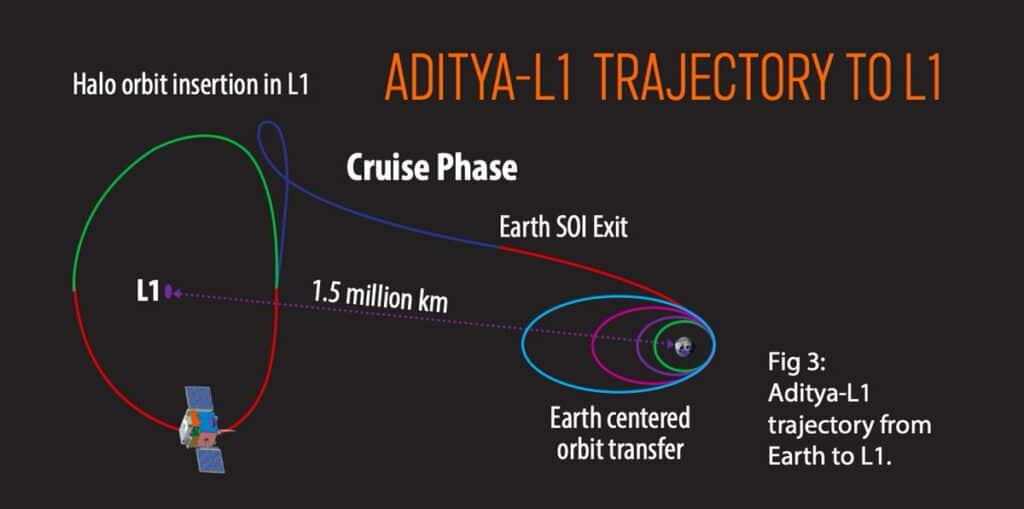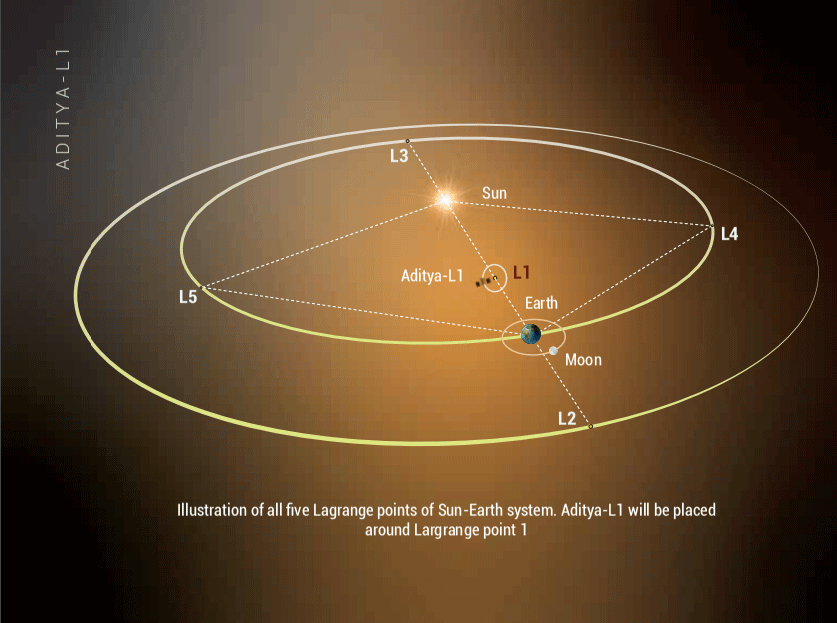On Sept 02, 2023, ISRO launched PSLV-C57/Aditya-L1 Mission at 11:50 am IST from the Second Launch Pad (SLP) at Satish Dhawan Space Centre, Shrikota, Andhra Pradesh.
At 11:54 AM IST, the payload pairing has been separated. Relative velocity 3.8 km/s. The spacecraft is functioning normally.
Sun, about 150 million kilometers from Earth, is a hot glowing ball of hydrogen and helium gases. Without solar energy, life on Earth can not exist.
The Sun constantly influences the Earth with radiation, heat, and a constant flow of particles and magnetic fields.
Through this mission, ISRO ventures into the study of solar activities and their effect on space weather.
Aditya-L1:
The first Indian solar mission to investigate the Sun in orbit is called Aditya L1. The spacecraft will be positioned in a halo orbit around the Sun-Earth system’s Lagrangian point 1 (L1).
You read that correctly. The Sun is different from where Aditya-L1 is going. Instead, it travels to a spot in space known as the Lagrange 1 or L1 point (thus, Aditya-L1), which is only 1% as far from Earth as the Sun is!
The main benefit of having a satellite in the halo orbit around the L1 point is that it can continuously see the Sun without being blocked by an eclipse or occultation. The benefit of constantly studying solar activity will increase as a result.

The Lagrange Points:
The Lagrange Points are the locations in space where, if a small object is placed there, it tends to stay. The spacecraft may use these locations in space for a two-body system, like the Sun and Earth, in order to maintain its current position while using less fuel.
Technically, the gravitational pull of the two massive objects at Lagrange point equals the centripetal force required for a tiny item to move in the same direction as them. There are a total of five Lagrange points for two-body gravitational systems, identified as L1, L2, L3, L4, and L5. The Sun-Earth line is where the Lagrange point L1 is located. L1 is located around 1% of the Earth-Sun distance away from Earth.

Payloads:
The spacecraft has seven payloads that use particle and electromagnetic detectors to study the photosphere, chromosphere, and the Sun’s outermost layers (the corona). Four payloads see the Sun directly using the particular advantage point of L1, while the remaining three payloads conduct in-situ particle and field research at the Lagrange point L1.
To comprehend issues with coronal heating, Coronal Mass Ejection, pre-flare and flare activities, and their characteristics, dynamics of space weather, study of the propagation of particles and fields in the interplanetary medium, etc., the Aditya L1 payloads are expected to provide the most important information.
- The Visible Emission Line Coronagraph (VELC) studies the solar corona and the dynamics of
Coronal Mass Ejections. - The Solar Ultra-violet Imaging Telescope (SUIT) payload images of the Solar Photosphere and Chromosphere in near Ultra-violet (UV) and also measures the solar irradiance variations in near UV.
- The Aditya Solar Wind Particle Experiment (ASPEX) and Plasma Analyser Package for Aditya (PAPA) payloads study the solar wind and energetic ions and their energy distribution.
- The Solar Low Energy X-ray Spectrometer (SoLEXS) and The High Energy L1 Orbiting X-ray Spectrometer (HEL1OS) studies the X-ray flares
from the Sun over a wide X-ray energy range. - The Magnetometer payload can measure interplanetary magnetic fields at the L1 point.
Objectives:
- Understanding the solar wind acceleration and coronal heating.
- Understanding the beginnings of flares, CMEs, and near-Earth space weather.
- To comprehend the dynamics and connectivity of the solar atmosphere.
- To comprehend the temperature anisotropy and solar wind distribution.
The spacecraft will first be positioned in a low Earth orbit. The orbit will then be made more elliptical, and utilizing onboard propulsion, the spacecraft will be launched toward the Lagrange point L1. The spacecraft will leave the gravitational Sphere of Influence (SOI) of the Earth as it moves closer to L1. After leaving SOI, the spacecraft will enter its cruise phase before being sent into a massive halo orbit around L1. Aditya-L1 would require roughly four months to travel from launch to L1.
